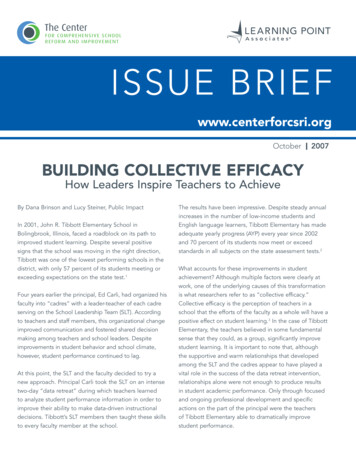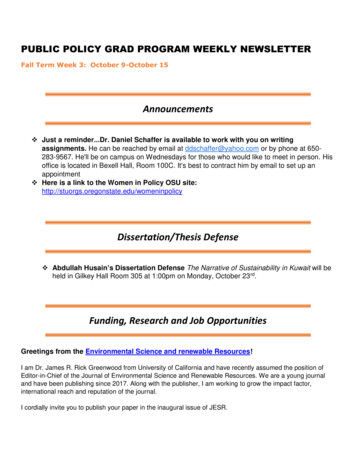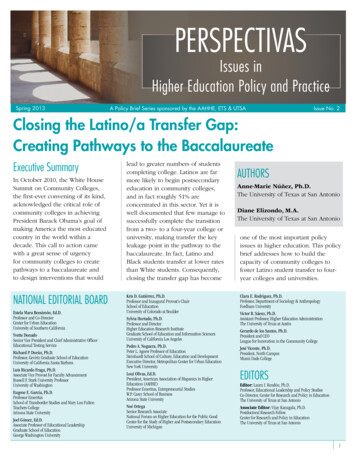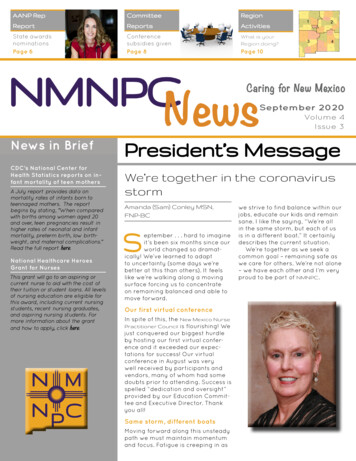
Transcription
ISSUE BRIEFwww.centerforcsri.orgOctober2007Building Collective EfficacyHow Leaders Inspire Teachers to AchieveBy Dana Brinson and Lucy Steiner, Public ImpactIn 2001, John R. Tibbott Elementary School inBolingbrook, Illinois, faced a roadblock on its path toimproved student learning. Despite several positivesigns that the school was moving in the right direction,Tibbott was one of the lowest performing schools in thedistrict, with only 57 percent of its students meeting orexceeding expectations on the state test.1Four years earlier the principal, Ed Carli, had organized hisfaculty into “cadres” with a leader-teacher of each cadreserving on the School Leadership Team (SLT). Accordingto teachers and staff members, this organizational changeimproved communication and fostered shared decisionmaking among teachers and school leaders. Despiteimprovements in student behavior and school climate,however, student performance continued to lag.At this point, the SLT and the faculty decided to try anew approach. Principal Carli took the SLT on an intensetwo-day “data retreat” during which teachers learnedto analyze student performance information in order toimprove their ability to make data-driven instructionaldecisions. Tibbott’s SLT members then taught these skillsto every faculty member at the school.The results have been impressive. Despite steady annualincreases in the number of low-income students andEnglish language learners, Tibbott Elementary has madeadequate yearly progress (AYP) every year since 2002and 70 percent of its students now meet or exceedstandards in all subjects on the state assessment tests.2What accounts for these improvements in studentachievement? Although multiple factors were clearly atwork, one of the underlying causes of this transformationis what researchers refer to as “collective efficacy.”Collective efficacy is the perception of teachers in aschool that the efforts of the faculty as a whole will have apositive effect on student learning.3 In the case of TibbottElementary, the teachers believed in some fundamentalsense that they could, as a group, significantly improvestudent learning. It is important to note that, althoughthe supportive and warm relationships that developedamong the SLT and the cadres appear to have played avital role in the success of the data retreat intervention,relationships alone were not enough to produce resultsin student academic performance. Only through focusedand ongoing professional development and specificactions on the part of the principal were the teachersof Tibbott Elementary able to dramatically improvestudent performance.
ISSUE BRIEFCollective Efficacy—Its Importance toEducation LeadersIn his January 2007 Issue Brief, Believingand Achieving, Craig Jerald highlighted howteacher perceptions of individual and collectiveefficacy indirectly influence student learning.4Jerald notes that research has shown thatteachers with strong perceptions of efficacyput more effort into planning lessons, are moreopen to new ideas, and persevere in the faceof new challenges. What is most promisingabout this line of research, suggests Jerald, isthat efficacy perceptions are not set in stone.Building on Jerald’s work, this brief focuseson one vital aspect of efficacy known as“collective teacher efficacy” (CTE). CTE refersto the perceptions of teachers that the effortsof the faculty as a whole will have a positiveeffect on students.CTE generally is measured by averaging theresponses of a school’s individual teachers to aseries of questions on a survey. Teachers withstronger perceptions of collective efficacy aremore likely to say they agree with statementslike “teachers in this school have what it takesto get the children to learn” and “teachershere are well-prepared to teach the subjectsthey are assigned to teach.” Likewise, teachers with strong collective efficacy are more likelyto say they disagree with statements such as“students here just aren’t motivated to learn”or “teachers in this school think there are somestudents that no one can reach.”5Principals and district leaders should turn theirattention to improving CTE because it hasan impressive list of positive consequences.Strong collective efficacy: improves student performance ameliorates the negative effects of lowsocioeconomic status (SES) enhances parent/teacher relationships creates a work environment that buildsteacher commitment to the schoolImproves Student PerformanceResearch demonstrates that collective teacherefficacy has a strong measurable effect onstudent performance. In their study of 452urban elementary teachers in 47 schools,Goddard, Hoy, and Woolfolk Hoy (2000)found that a one-point increase in a school’scollective efficacy score (on a six-point scale)is associated with about an 8.5-point increasein student achievement scores—an increasesocial scientists would call a moderate effect.6Indeed, they found that even when takinginto consideration the effects of studentdemographics such as race, socioeconomicstatus, and gender (that is, factors beyonda school’s control), perceptions of collectiveefficacy still were strong predictors ofacademic performance.7Ameliorates Effects of Low SESBandura (1993) noted that the positive effectsof CTE on student academic performancemore than outweigh the negative effects oflow socioeconomic status.8 Goddard et al.(2000) confirmed this finding in their study,which demonstrated that between-schooldifferences in collective efficacy had a strongerpositive relationship with mathematics andreading achievement than low socioeconomicstatus had a negative relationship.9 Thissuggests that in schools with otherwise similardemographics, principals who work to buildcollective teacher efficacy will make greaterstrides toward closing the achievement gap intheir schools.Enhances Parent/Teacher RelationshipsIn addition to improving student performance,teachers at schools with strong CTE appear tobe more comfortable reaching out to parents.Ross and Gray (2006) suggest that becauseinvolving parents exposes teachers to therisk that parents will criticize the school oridentify different goals or values than those
Builds Teacher CommitmentThe strength or weakness of CTE helps orhinders the positive effects of individualefficacy.11 That is, stronger collective efficacyencourages individual teachers to moreeffectively deploy the skills they already have,find new ways to tackle difficult challenges,and share what they know with others.Research has shown that “groups with highercollective efficacy set more difficult groupgoals and [are] more committed to thosegoals.”12 Collective efficacy, then, is a key tounlocking the existing talents of individualteachers and building their commitment to theschool’s success.Building CollectiveEfficacy in SchoolsThere is not a failsafe set of steps thatschool leaders can take to improve collectiveefficacy among teachers at any given school.Nevertheless, research does offer someguidance for leaders who want to prioritizetheir actions to ensure that they are focusingon interventions that have the highestlikelihood of increasing collective efficacy. Thisissue brief will summarize what is known aboutthe actions that principals can take to increasecollective efficacy among their faculty.In a recent study involving 1,981 K–8teachers, Goddard and Skrla (2006) found thatcontextual and demographic factors such as aschool’s socioeconomic status, the experiencelevel of the faculty, and students’ prioracademic performance accounted for less thanhalf (46 percent) of the differences in collectiveefficacy between schools.13 This suggeststhat there are several other factors at work inbuilding collective efficacy that principals anddistrict leaders can influence.Only in the last decade or so have researchersbegun to look at specific actions that school ordistrict leaders can take to improve collectiveefficacy among teachers. This emerging bodyof research, though still in its early stages,suggests that the following actions on the partof principals can improve collective efficacy: Build instructional knowledge and skills.ISSUE BRIEFidentified by the school, schools with low CTEare less likely to engage parents. A staff thatis confident in their own abilities and in theireffectiveness, on the other hand, is more likelyto welcome parental participation becausethey believe they will be able to withstandthese challenges.10 Create opportunities for teachers tocollaboratively share skills and experience. Interpret results and provide actionablefeedback on teachers’ performance. Involve teachers in school decision making.14Build Instructional Knowledgeand SkillsIn their review of two efforts in Cincinnatiand Philadelphia to implement communitiesof instructional practice in large schools,Supovitz and Christman (2003) found thatthe link between greater teacher collegialityand improved academic achievement amongstudents was not as direct as initially believed.Interventions designed to improve teamworkand communication among teachers, fostersharing of best practices, and strengthenteacher relationships with students and parentsdid not necessarily translate into more effectiveteaching and better student performance.Supovitz and Christman found, however, thatthe schools that did achieve better resultshad leaders who provided opportunitiesfor “structured, sustained, and supportedinstructional discussions” and “investigated therelationships between instructional practicesand student work.”15 In short, when leadersprovided frequent, structured opportunitiesfor teachers to focus on instructional practices,teachers translated this new knowledge intomore effective teaching.
ISSUE BRIEFCreate Opportunities for CollaborationIn the Tibbott Elementary case, the SchoolLeadership Team’s decision to participate in adata retreat that led to schoolwide data analysistraining created ongoing opportunities forthe faculty to collaborate around instructionalpractice. Data retreats can offer a very powerfulchange tool to principals and teachers becausethey provide detailed, specific informationabout poor student performance that enablesteachers to develop a targeted approach toimproving student achievement.Site visits offer another potentially powerfulopportunity for collaboration. If a principal isattempting to implement a new instructionalprogram with a faculty that has experiencedfailure in the past, has poor perceptions ofcollective efficacy, and has little or no priorexposure to highly effective instructionalpractices, they may benefit greatly from visitinga site where the new program has worked—especially if the model school has faced thesame challenges and overcome them.16 Even less structured collaboration efforts maymaintain or improve perceptions of efficacy.In a very small sample of seven teacherswho began a voluntary professional studygroup, Pfaff (2000) found that teachers withalready high levels of efficacy maintainedthose levels during the course of the year,unlike their peers who did not participate inthe study group. Many of those who did notparticipate suffered a significant decrease inefficacy perceptions.17 This study indicates thatprincipals can support perceptions of efficacyeven with limited resources if they can designinterventions that are focused on instructionalpractices and promote increased sharing ofskills and experiences between teachers.Interpret Results and Provide FeedbackAccording to Lindsley, Brass, and Thomas(1995), one of the most important aspects ofa leader’s role in improving perceptions ofcollective efficacy is to help a group interpretperformance results. Rather than simply statingthe outcomes, principals need to contextualizethe results in three ways: Identify specific efforts that resulted insuccess to build on in future endeavors. Explain how the results fit into acommunally-shared understanding of whatconstitutes success. Present the outcomes in a manner thatdevelops confidence while tempering trendstoward overconfidence and complacency(if the outcome is successful) or defeatism (ifthe outcome is negative).18Leaders who identify the reasons for successwhen they present positive results and who areable to temper success with the recognition thatthere will be challenges ahead can inspire theirfaculty to continue working to improve theirpractice.19 High-quality, detailed performancefeedback is necessary to build an organizationwith high collective efficacy that recognizes thatit can face the challenges ahead.Involve Teachers in SchoolDecision MakingGoddard, Hoy, and Woolfolk Hoy (2004) statethat, “the more teachers have the opportunityto influence instructionally relevant schooldecisions, the more likely a school is to becharacterized by a robust sense of collectiveefficacy.”20 These researchers further describevarious ways that teachers can influenceinstructionally relevant school decisions,including control over curriculum, instructionalmaterials, and activities; professionaldevelopment; communication with parents;student placement; and disciplinary policies.At Tibbott Elementary, Principal Carli built onthe successes of the data retreat by takingthe School Leadership Team to a leadershipinstitute to build their confidence andleadership skills. By continually fostering astrong group of leader-teachers, Principal Carliensured that teachers were equipped and
ConclusionRichard Elmore’s well-regarded monograph,Building a New Structure for SchoolLeadership, argues that the key barrier tosuccessfully and dramatically improvingstudent performance is the fact that toomany teachers are isolated and have littleopportunity for professional collaborationwith colleagues, the principal, or the district.21Building collective teacher efficacy—byproviding teachers with opportunities to buildinstructional knowledge and collaborate withcolleagues, with feedback that is insightfuland with a vision of success in which teachersare treated as sources of expertise—willallow leader
Four years earlier the principal, Ed Carli, had organized his faculty into “cadres” with a leader-teacher of each cadre serving on the School Leadership Team (SLT). According to teachers and staff members, this organizational change improved communication and fostered shared decision making among teachers and school leaders. Despite improvements in student behavior and school climate .











